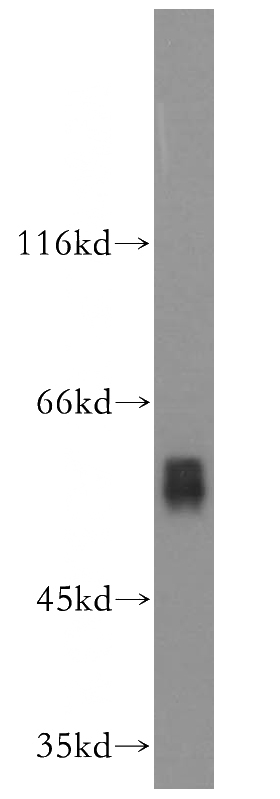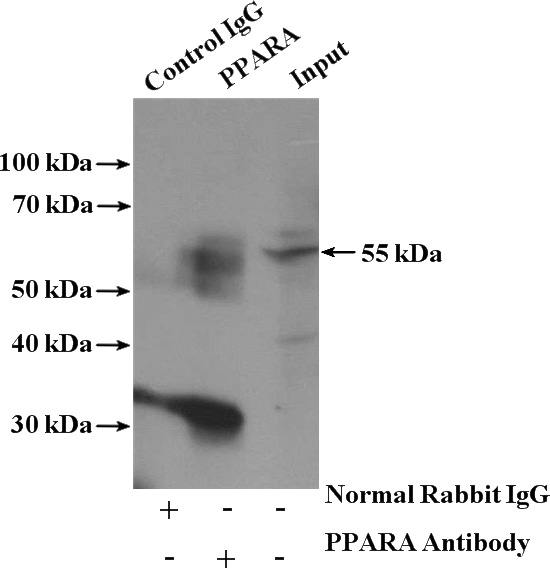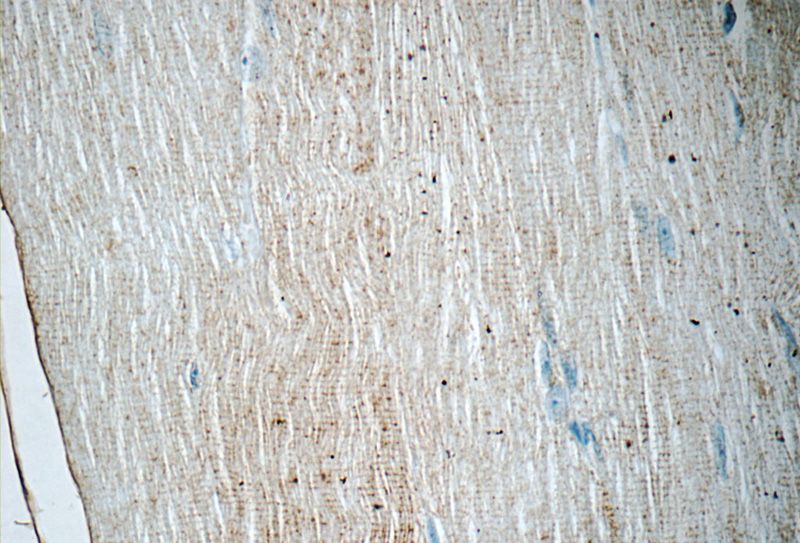-
Product Name
PPARA antibody
- Documents
-
Description
PPARA Rabbit Polyclonal antibody. Positive IHC detected in human skeletal muscle tissue. Positive WB detected in U-937 cells, HepG2 cells, MCF7 cells, mouse skeletal muscle tissue, NIH/3T3 cells. Positive IP detected in U-937 cells. Observed molecular weight by Western-blot: 52-55 kDa
-
Tested applications
ELISA, WB, IHC, IP
-
Species reactivity
Human,Mouse,Rat; other species not tested.
-
Alternative names
hPPAR antibody; NR1C1 antibody; PPAR antibody; PPAR alpha antibody; PPARA antibody
-
Isotype
Rabbit IgG
-
Preparation
This antibody was obtained by immunization of PPARA recombinant protein (Accession Number: BC000052). Purification method: Antigen affinity purified.
-
Clonality
Polyclonal
-
Formulation
PBS with 0.02% sodium azide and 50% glycerol pH 7.3.
-
Storage instructions
Store at -20℃. DO NOT ALIQUOT
-
Applications
Recommended Dilution:
WB: 1:200-1:1000
IP: 1:200-1:1000
IHC: 1:20-1:200
-
Validations

U-937 cells were subjected to SDS PAGE followed by western blot with Catalog No:114083(PPARA antibody) at dilution of 1:100

IP Result of anti-PPARA (IP:Catalog No:114083, 4ug; Detection:Catalog No:114083 1:300) with U-937 cells lysate 4000ug.

Immunohistochemistry of paraffin-embedded human skeletal muscle tissue slide using Catalog No:114083(PPARA Antibody) at dilution of 1:50 (under 40x lens)
-
Background
Peroxisome proliferator-activated receptor alpha (PPARA) is a ligand-activated transcription factor that belongs to the PPAR nuclear receptor superfamily. PPARA is essential in the modulation of lipid transport and metabolism, mainly through activating mitochondrial and peroxisomal fatty acid β-oxidation pathways. In addition, PPARA seems to decrease inflammation mainly through direct interaction with NF-κB, causing inhibition of its signaling pathway or reducing the activated levels of NF-κB and subsequent inflammation. Furthermore, PPARA was implicated in the attenuation of oxidative stress in alcoholic liver disease when treated with polyenephosphatidylcholine through downregulation of ROS-generating enzymes such as ethanol-inducible cytochrome P450 2E1 (CYP2E1), acyl-CoA oxidase, and NADPH oxidase.
-
References
- Hu YW, Ma X, Huang JL. Dihydrocapsaicin Attenuates Plaque Formation through a PPARγ/LXRα Pathway in apoE(-/-) Mice Fed a High-Fat/High-Cholesterol Diet. PloS one. 8(6):e66876. 2013.
- Zhang S, Zheng L, Dong D. Effects of flavonoids from Rosa laevigata Michx fruit against high-fat diet-induced non-alcoholic fatty liver disease in rats. Food chemistry. 141(3):2108-16. 2013.
- Xu T, Zheng L, Xu L. Protective effects of dioscin against alcohol-induced liver injury. Archives of toxicology. 88(3):739-53. 2014.
- Yan S, Zhang Q, Zhong X. I prostanoid receptor-mediated inflammatory pathway promotes hepatic gluconeogenesis through activation of PKA and inhibition of AKT. Diabetes. 63(9):2911-23. 2014.
- Keith D, Finlay L, Butler J. Lipoic acid entrains the hepatic circadian clock and lipid metabolic proteins that have been desynchronized with advanced age. Biochemical and biophysical research communications. 450(1):324-9. 2014.
- Dong D, Qi Y, Xu L. Total saponins from Rosa laevigata Michx fruit attenuates hepatic steatosis induced by high-fat diet in rats. Food & function. 5(12):3065-75. 2014.
- Wang D, Chen S, Liu M, Liu C. Maternal obesity disrupts circadian rhythms of clock and metabolic genes in the offspring heart and liver. Chronobiology international. 32(5):615-26. 2015.
- Ma J, Bai J. Protective effects of heparin on endothelial cells in sepsis. International journal of clinical and experimental medicine. 8(4):5547-52. 2015.
Related Products / Services
Please note: All products are "FOR RESEARCH USE ONLY AND ARE NOT INTENDED FOR DIAGNOSTIC OR THERAPEUTIC USE"
